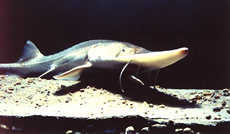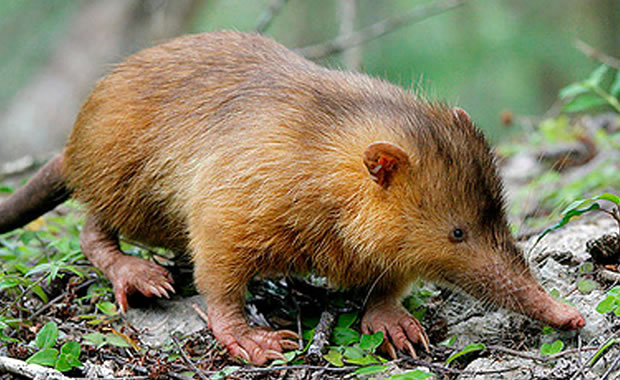Creature Profile
The pallid sturgeon is a large fish found in the Missouri-Mississippi River drainage. It is also called the white sturgeon due to its light coloring. Adults weigh up to 85 lbs and are generally between 30 and 60 inches in length. The snout is flattened and shaped like a shovel, and the mouth is toothless and is found far under the snout. In front of the mouth is a row of sensory barbells which aid in finding food. The jaw is arranged so that the mouth can be extended or withdrawn while feeding. The outward appearance of the pallid sturgeon is very prehistoric-like, and it has been called the ugliest fish of North America.
The habitat preferences of this species are not well known, but it is believed that pallid sturgeons prefer to dwell in sandy or rocky bottoms of large, turbid, free-flowing rivers. Specimens have been found at the bottoms of rivers, lakes, streams, and deep pools in sand flats or gravel bars. They seem to prefer swift river currents and are usually found from three to 25 feet deep in the water. They are generally bottom feeders, skimming the sandy river floors using their barbells to find food. Diet consists of insects and other aquatic vertebrates and fish. Very little is known about the reproductive behavior of this species. Spawning occurs in June and July.
The pallid sturgeon was probably never a common creature throughout its range, and is now considered one of the rarest inhabitants of the Mississippi and Missouri Basins. Causes of decline include human habitat disturbance through the building of dams and reservoirs. Modifications such as these have limited the movement of the species or have destroyed or altered spawning areas, and reduced food supply. The species has also suffered from pollution and commercial harvesting. Harvesting has been banned and the species is now legally protected in its entire range. There are also plans by the US Fish & Wildlife Service to begin a captive-breeding program and possible introduction of captive-bred sturgeons into their historical habitats.
Wikipedia Article

|
Wikipedia Article Copyright Notice: This article is licensed under the GNU Free Documentation License. It uses material from the Wikipedia article "Pallid sturgeon". |
May 9, 2017
Glenn, C. R. 2006. "Earth's Endangered Creatures - Pallid Sturgeon Facts" (Online). Accessed 4/20/2024 at http://earthsendangered.com/profile.asp?sp=882&ID=9.
Need more Pallid Sturgeon facts?




